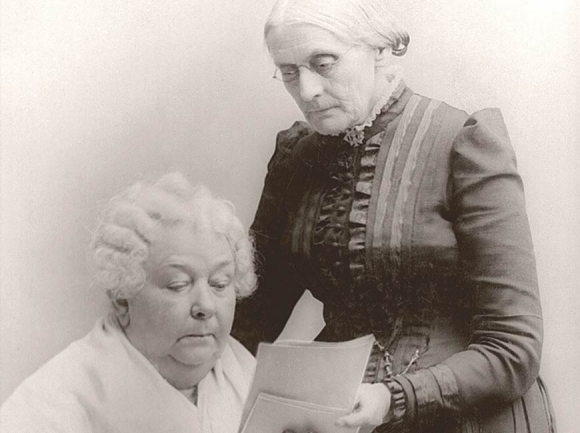The Anthony Amendment: Women’s suffrage in NC and beyond
 Suffragists Elizabeth Cady Stanton (left) and Susan B. Anthony played a pivotal role in passage of the 19th Amendment. Wikimedia photo
Suffragists Elizabeth Cady Stanton (left) and Susan B. Anthony played a pivotal role in passage of the 19th Amendment. Wikimedia photo
When the United States Constitution was adopted in 1787, left to the states was the power to determine who should be allowed to vote in elections. While several states indeed permitted some women to vote in various elections, the right of suffrage was far from universal.
Changing that would require an amendment to the Constitution — a lengthy and onerous process. After a seven-decade fight, universal suffrage for women was finally within reach when on Aug. 17, 1920, eyes across the country trained on North Carolina as the state that might make it so.
Events leading up to that August day in Raleigh a century ago are complex but can be traced back to an 1848 gathering in New York.
The Seneca Falls Convention is widely acknowledged as the first organized effort to discuss “the social, civil and religious condition and rights of woman.”
Organized by activist Elizabeth Cady Stanton, the convention resulted in the issuance of The Declaration of Sentiments. It mirrors the Declaration of Independence in structure, style and strength.
When, in the course of human events, it becomes necessary for one portion of the family of man to assume among the people of the earth a position different from that which they have hitherto occupied, but one to which the laws of nature and of nature’s God entitle them, a decent respect to the opinions of mankind requires that they should declare the causes that impel them to such a course …
Related Items
We hold these truths to be self-evident: that all men and women are created equal; that they are endowed by their Creator with certain inalienable rights; that among these are life, liberty, and the pursuit of happiness; that to secure these rights governments are instituted, deriving their powers from the consent of the governed. Whenever any form of government becomes destructive of these rights, it is the right of those who suffer from it to refuse allegiance to it, and to insist upon the institution of a new government, laying its foundation on such principles, and organizing its powers in such form, as to them shall seem most likely to effect their safety and happiness …
Now, in view of this entire disfranchisement of one-half the people of this country, their social and religious degradation, - in view of the unjust laws above mentioned, and because women do feel themselves aggrieved, oppressed, and fraudulently deprived of their most sacred rights, we insist that they have immediate admission to all the rights and privileges which belong to them as citizens of these United States.
The movement languished during the Civil War, but in 1866 was formalized when the American Equal Rights Association was founded by Stanton, along with abolitionist Frederick Douglass and social reformers Susan B. Anthony and Lucretia Mott.
The AERA split in 1870 over the 15th Amendment, which doesn’t mention women’s suffrage but does say that “The right of citizens of the United States to vote shall not be denied or abridged by the United States or by any State on account of race, color, or previous condition of servitude.”
Stanton and Anthony were opposed to Black male suffrage, and the 15th Amendment, and the male immigrants it would also empower. They formed the National Women’s Suffrage Association.
Another group, called the American Women’s Suffrage Association and led by suffragist Lucy Stone and poet Julia Ward Howe, supported the 15th Amendment while still pursuing universal suffrage for women.
An 1878 women’s suffrage amendment introduced by a U.S. Senator from California was “indefinitely postponed,” but not before 30,000 people had signed petitions of support.
That led to the establishment of a Senate committee in 1882, which in turn led to a floor vote on women’s suffrage in 1887.
The “Susan B. Anthony Amendment,” as it was called, was defeated 34 to 16, far below the two-thirds majority needed for passage.
Perhaps a blessing in disguise, the defeat was quickly followed in 1890 by a merger of the two competing suffrage organizations into a new one — the National American Women’s Suffrage Association (NAWSA), led by Stanton.
Activism continued through the turn of the century on both sides; a Dec. 11, 1894 letter to the editor of the Asheville Daily Citizen written anonymously by “A North Carolina Woman” points out that the issue of suffrage was also intertwined with that of race.
“Whilst the ripple of Women’s Suffrage is stirring the stagnant pool of prejudices in our dear old State of North Carolina I feel moved to express utterances that occur in my vicinity,” she wrote. “Some of our men are only opposed to a Women’s Suffrage on the grounds that ‘in our Southern country it would put a great power in the hands of negro women.’”
NAWSA would again see a floor vote of the Anthony Amendment in the Senate in 1914, but it was defeated soundly.
By this time universal women’s suffrage was also tied closely to auxiliary causes espoused by its supporters, including trade unionists and the temperance movement. This made the decision on suffrage much more difficult for everyone, including the anti-labor south and the anti-prohibition north.
Once again war intervened, but this time, the suffrage movement continued unabated. More than a dozen states had already granted suffrage to women, North Carolina not among them.
In advance of a January 1918 House vote on the Anthony Amendment, a story in the Carolina Mountaineer-Waynesville Courier detailed Western North Carolina Democratic Congressman Zebulon Weaver’s stance on the issue.
Weaver was perhaps a man ahead of his time; born in 1872 in (of course) Weaverville, he studied law at UNC-Chapel Hill and began practicing in Asheville in 1894. After a term in both the N.C. House and Senate, he served as Western North Carolina’s congressman from 1917 to 1919, and then from 1921 to 1928, and then again from 1930 to 1943.
During the 1920s, Weaver corresponded by letter with prominent Appalachian naturalist Horace Kephart and was credited for his advocacy on behalf of the Great Smoky Mountains National Park and the Blue Ridge Parkway.
He also benefitted from the support of Dillsboro civic leader Gertrude Dills McKee who went on to become a groundbreaking politician in her own right.
Near the end of his first term, Weaver was the only North Carolina congressman to support the Anthony Amendment.
“I am going to cast my vote for suffrage. I see no reason why the women of the United States and the South should not vote,” Weaver told the Mountaineer-Courier in January, 1918. “That is, those that desire the ballot should not be denied the privilege; there are vast numbers of women who are large property holders and I feel that it is just to them that they shall decide how they are to be governed and taxed.”
The Anthony Amendment passed the House of Representatives that very month, by one vote.
On Sept. 30, 1918, with the end of World War I just weeks away, President Woodrow Wilson likewise asked the Senate to pass the Anthony Amendment. It failed the next day by two votes.
Three months later, in February 1919, it again failed, this time by one vote.
Not everyone was disappointed. On Feb. 20, 1919, the Mountaineer-Courier reprinted a letter sent by Newton, N.C., woman Kitty Ruskin to the Charlotte Observer.
“It is sickening and disgusting to me as a Southern woman. Why should I want to vote? Do we not have the best government on God’s green earth the way it is?” she wrote. “… I have only one desire, or two. … First, that from now until the gates of eternity are unlocked, the Women’s Suffrage movement will be defeated and persecuted; and secondly, that the women of the dear old southland will forever stand out nobly against this pest, this menace, and defeat it.”
Mountaineer-Courier Editor Jesse Daniel Boone, who was given to printing his poems on the front page of his paper, may have seen the writing on the wall two months later when he penned the following:
Our women long have been kept down,
And were denied both place and crown;
But soon a nation-wide decree
Will let them vote and set them free.
Less than two months after Boone’s April 10, 1919 verse the Anthony Amendment passed the Senate by a comfortable margin, on June 4.
But that wasn’t the end of it.
There are a couple of ways to amend the Constitution but only one of them has ever been pursued. A proposed amendment can be introduced in either the House or the Senate but must eventually pass both by a two-thirds majority.
After repeated attempts over 41 years, the Susan B. Anthony Amendment had finally accomplished that feat in 1919, but a proposed amendment must thereafter be ratified by legislatures in three-fourths of the existing states, at that time numbering 48.
Less than a week after clearing the Senate, the Anthony Amendment was first ratified by Illinois, Wisconsin and Michigan, all on the same day.
Local advocacy surrounding the issue ramped up, especially in North Carolina. Esteemed Democrat and three-time presidential candidate William Jennings Bryan addressed a suffrage meeting in Raleigh, and on June 30, prominent early feminist Mary Elizabeth Pidgeon of Winchester, Virginia, traveled to Waynesville to speak.
Six more states ratified the Anthony Amendment that month, and four more followed in July.
By the end of 1919, 22 states had ratified the Anthony Amendment. Opinion pieces in Western North Carolina newspapers began to reveal more and more support for ratification.
“When the legislature meets in extraordinary session next July it will be confronted with the question of ratification of the amendment to the federal constitution granting the suffrage to the women,” reads one such editorial in the Nov. 28, 1919 issue of the Sylva-based Jackson County Journal. “Personally we can see no reason why the women citizens and taxpayers of the country should not be given the privilege of voting if they want to do so.”
In March 1920, Washington became the 35th state to ratify the Anthony Amendment — one short of the 36 required.
Legislatures went into summer recess but as some reconvened early, the Old North State was poised to vote on Aug. 17, 1920.
Front-page headlines in the Aug. 17 issue of the Hickory Daily Record proclaim “Women’s Suffrage Battle is Begun in State Senate Today,” and “Senate is Scene of Vigorous Battle.”
In the end, ratification of the Anthony Amendment in North Carolina’s legislature failed by two votes.
The very next day, the main headline in the Daily Record read, “Tennessee Has Ratified U.S. Suffrage Amendment,” noting that the Volunteer State had forever taken its rightful place in history as the state that pushed women’s suffrage over the top.
Although the Anthony Amendment became the law of the land at that time, North Carolina went on to become the second-to-last state — ahead of only Mississippi — to ratify it in 1971.









